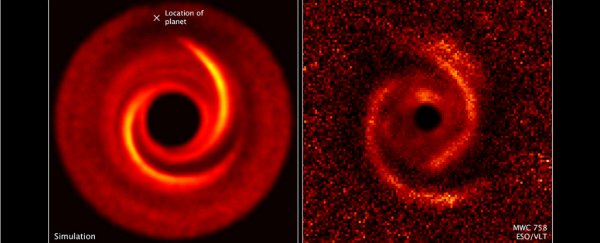Spotting planets isn't quite as simple as pointing a telescope out into space: astronomers have to make all sorts of calculations about light, distance and gravity to try and piece together the jigsaw of the universe and work out where planets are located, and the further from Earth you look the more difficult this becomes. Now new research reported by the Atlantic suggests giant planets 10 times the size of Jupiter could have been hiding from us.
These planets, a fresh theory suggests, could be creating the gigantic spiral disks that appear after stars are formed in space. We've known about these circumstellar disks for some time, mixtures of gas and dust that can be seen a few million years after a star is born, but now astrophysicists Ruobing Dong, of the Lawrence Berkeley National Laboratory, and Zhaohuan Zhu, of Princeton University, think huge planets are part of this cosmic dance as well… we just can't actually see them.
"It's difficult to see suspected planets inside a bright disk surrounding a young star," Dong said in a press statement. "Based on this study, we are convinced that planets can gravitationally excite structures in the disk. So if you can identify features in a disk and convince yourself those features are created by an underlying planet that you cannot see, this would be a smoking gun of forming planets."
Using a combination of images taken from powerful telescopes and computer modelling software, scientists are learning more about the far reaches of space than ever before – even if planets themselves cannot be seen, their effects on other bodies can. By simulating how a star's radiation spreads through its surrounding disk, Dong and Zhu found what they think is evidence of giant planets: if they're right, it could change our understanding of how stars are formed and help researchers spot other planets in the future.
The scientists say their computer simulations found evidence of deep space activity that resembled "traffic backing up on a crowded expressway". The position and mass of the hidden planets are causing this celestial traffic jam, Dong and Zhu believe, teasing out the spiralling arms of the circumstellar disks they're a part of. The theory goes that if the planets weren't there, the disks would be flat.
What makes the findings more interesting are that they're taken from very early on in the life of a star and its associated planets, and that could potentially give us more clues about the growth of galaxies. "There are many theories about how planets form but very little work based on direct observational evidence confirming these theories," adds Dong. "If you see signs of a planet in a disk right now, it tells you when, where, and how planets form."
